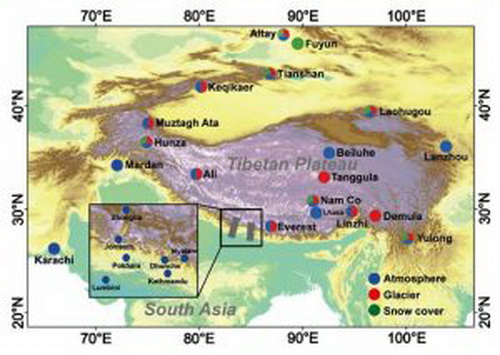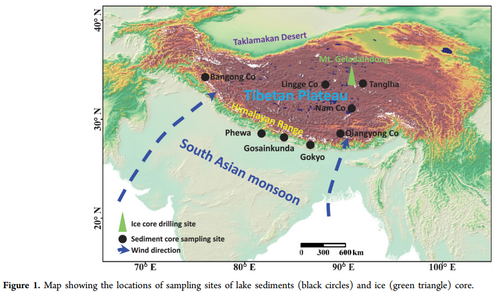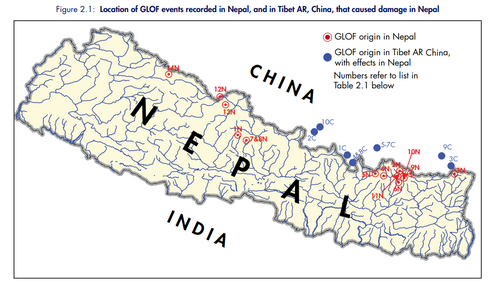As China has expanded its capacity in glacier research in recent years, it has also developed its collaborations with other nations, particularly Nepal, in this area.
Chinese glaciological activities date back to the 1950s, and underwent an expansion with the establishment of the Lanzhou Institute of Glaciology and Geocryology, located in the central province of Gansu, in the 1980s. An Ice Core Laboratory was created in 1991, which expanded into the Cold and Arid Regions Environmental and Engineering Research Institute (CAREERI), a component of the Chinese Academy of Sciences. The State Key Laboratory of Cryospheric Science (SKLCS) was established in 2007 by CAREERI and the Institute of Tibetan Plateau Research, which is also a unit within the Chinese Academy of Sciences.

SKLCS research sites in China, Nepal and Pakistan (source: SKLCS).
The SKLCS also supports China’s research in Antarctica. As professor Ren Jiawen of SKLCS explained to GlacierHub, this polar work began with the establishment of stations on the Antarctic Peninsula in the 1980s, and in the 1990s at Prydz Bay and on the Antarctic Plateau. In addition, China’s Arctic Yellow River Station in Svalbard was opened in 2004. These high latitude efforts show the logic of using the term “Third Pole” to describe the glacier and permafrost regions of high mountain Asia.
This growth of cryosphere research reflects the general expansion of the geosciences in China, and also the recognition of the environmental and economic importance of the cryosphere for China. Glacier meltwater is a major source of water in a number of small watersheds in the western portion of the country, and in one of China’s largest rivers as well. Glaciers supplied over 10 percent of the flow of the Yangtze River in the last decades of the 20th century. Though this contribution increased early in the present century, due to accelerated melt, the river is likely to reach “peak water” around 2030, and then decline, creating serious difficulties in the country, which has hoped to rely on transfers from the Yangtze watershed to alleviate water scarcity in the country’s north. Studies of the glaciers allow for more precise projections of the nation’s water resources.

Prof. Shichang Kang, director of SKLCS (source: CAS).
The SKLCS addresses other pressing cryosphere issues in China. The thawing of permafrost threatens important infrastructure projects, such as the Qinghai-Tibet Railway which links Lhasa with central China. And China is scheduled to host the 2022 Winter Olympics in Beijing and has turned to the SKLCS to help plan this event within the constraints of declining snow cover, forming a committee to “support and guarantee the snow and ice conditions during the Games.”
Though climate change is a major cause of glacier retreat in China, the deposition of black carbon—soot and other particles—on glaciers also plays a role. The burning of biomass and the use of diesel fuel in South Asia, especially India, provide a major source of this black carbon, which has been a focus of Chinese collaboration with Nepal in cryospheric research since its inception.

Map from recent paper by Kang, Sharma and others, showing transport of pollutants across the Himalayas (source: ES&T).
As Professor Shichang Kang, the director of SKLCS, told GlacierHub in a recent interview, “Since 2006, I started a collaboration with professor Subodh Sharma and Dr. Chhatra Sharma at Kathmandu University focusing on water, soil, and precipitation chemistry as well as toxic risk assessment in Nepal-Himalaya. This collaboration is still going on as we are training PhD students and young scientists.” He mentioned that this research examines a number of specific “pollutants in water, soil and air, including black carbon, polycyclic aromatic hydrocarbons [organic molecules which derive from biomass burning and other sources] and heavy metals (mercury, arsenic, lead etc.)”
Kang mentioned that the SKLCS “also started another collaboration in 2013, with ICIMOD [the International Center for Integrated Mountain Development, based in Kathmandu], working with Dr. Arnico Panday for air pollution observation in Nepal.” He stated that this research will continue to explore water quality and air quality, and look more extensively at “health risks associated with pollutants, the impacts of black carbon on cryospheric processes, and on the transport of atmospheric pollutants across the Himalayas into the Tibetan Plateau.” Black carbon in the Third Pole is a topic of concern for the Chinese Academy of Sciences.
Dr. Chhatra Sharma, a Nepali limnologist, also described this collaboration. He told GlacierHub, “I completed my Ph.D. at the Norwegian University of Life Sciences in 2008 and joined the faculty of Kathmandu University. A year later, I joined professor Kang’s group as a Young International Scientist Fellow in 2009. Kang is currently hosting two researchers within the President’s International Fellowship Initiative at present. And SKLCS and Kathmandu University have signed a memorandum of understanding for collaboration.” He added that he and Kang have co-authored 17 papers in peer-reviewed journals.
Among these papers is a study, published last year in Environmental Science & Technology, about the transport of heavy metal pollutants from South Asia into the Tibetan Plateau. The authors of this paper analyzed samples from ice cores and lake sediments in the Nepal Himalaya and the Tibetan Plateau. As this study shows, research on this subject requires the collection of field data on both the northern and southern sides of the Himalaya.

Map showing GLOFs in Nepal, including those which originated in China (source: ICIMOD).
These collaborations have allowed China to support its bilateral aid activities in Nepal. It partnered with ICIMOD to study glacier lake outburst floods, including ones which originate in Tibet and spread into Nepal. It put this information to use after the 7.8 earthquake in Nepal on April 25, 2015. It held an emergency meeting to assess the risk of landslides, debris flows and GLOFs, and sent information to agencies in Nepal.

Meeting at CAREERI to discuss April 2015 earthquake in Nepal (source: CAS)
These ties involve other countries as well. In addition to Nepali researchers, cryosphere scientists from Pakistan and Mongolia took part in the International Workshop on Cryospheric Change and Sustainable Development, held in August, at SKLCS in Lanzhou.
In 2015, China established the Belt Road Initiative, also known as the One Belt, One Road Initiative. Drawing on the history of the Silk Road, it seeks to promote infrastructure investments and trade with countries which neighbor China and beyond. In this context, scientific research, investment, trade and foreign policy can be integrated. In this way, Chinese cryosphere scientists and their collaborators in Nepal and elsewhere are responding to the pressures of climate change on glaciers.
Nepal signed a memorandum of understanding with China in May of this year, promoting its participation in the Belt and Road Initiative and facilitating Chinese investment to address Nepal’s infrastructure deficits. Historically, Nepal has shared close ties with India, a country with which it shares Hinduism as the majority religion. Nepali and Hindi are related languages, and Nepal’s transportation network has developed with roads across the lowland jungles that separate it from India, rather than across the high passes of the Himalayas.
But the potential of Chinese investment opens the possibility of a reconfiguratrion of transportation networks and of economic and political ties in the region. In this context, scientific research, investment, trade and foreign policy can be integrated. These efforts lead cryosphere scientists in China and Nepal to address the pressures of climate change on glaciers in their countries, and to explore ways to coordinate their activities. (GlacierHub)

